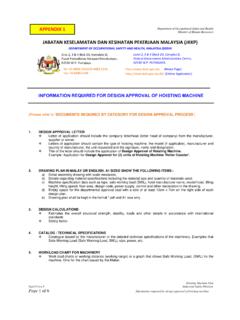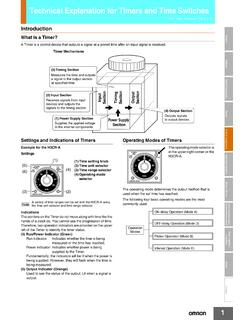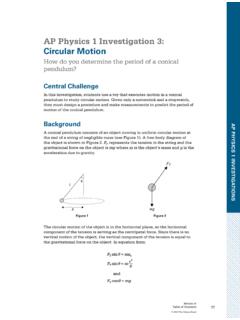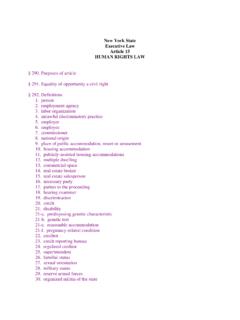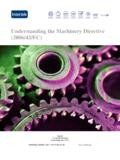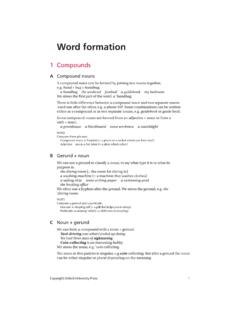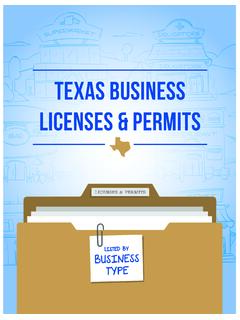Transcription of Lecture 1 INTRODUCTION TO HYDRAULICS AND PNEUMATICS
1 Lecture 1 INTRODUCTION TO HYDRAULICS AND PNEUMATICS Learning Objectives Upon completion of this chapter, the student should be able to: Explain the meaning of fluid power. List the various applications of fluid power. Differentiate between fluid power and transport systems. List the advantages and disadvantages of fluid power. Explain the industrial applications of fluid power. List the basic components of the fluid power. List the basic components of the pneumatic systems. Differentiate between electrical, pneumatic and fluid power systems. Appreciate the future of fluid power in India.
2 INTRODUCTION In the industry we use three methods for transmitting power from one point to another. Mechanical transmission is through shafts, gears, chains, belts, etc. Electrical transmission is through wires, transformers, etc. Fluid power is through liquids or gas in a confined space. In this chapter, we shall discuss a structure of hydraulic systems and pneumatic systems. We will also discuss the advantages and disadvantages and compare hydraulic, pneumatic, electrical and mechanical systems. Fluid Power and Its Scope Fluid power is the technology that deals with the generation, control and transmission of forces and movement of mechanical element or system with the use of pressurized fluids in a confined system.
3 Both liquids and gases are considered fluids. Fluid power system includes a hydraulic system (hydra meaning water in Greek) and a pneumatic system (pneuma meaning air in Greek). Oil hydraulic employs pressurized liquid petroleum oils and synthetic oils, and pneumatic employs compressed air that is released to the atmosphere after performing the work. Perhaps it would be in order that we clarify our thinking on one point. By the term fluid we refer to air or oil, for it has been shown that water has certain drawbacks in the transmission of hydraulic power in machine operation and control.
4 Commercially, pure water contains various chemicals (some deliberately included) and also foreign matter, and unless special precautions are taken when it is used, it is nearly impossible to maintain valves and working surfaces in satisfactory condition. In the cases where the hydraulic system is closed ( , the one with a self-contained unit that serves one machine or one small group of machines), oil is commonly used, thus providing, in addition to power transmission, benefits of lubrication not afforded by water as well as increased life and efficiency of packings and valves.
5 It should be mentioned that in some special cases, soluble oil diluted with water is used for safety reasons. The application of fluid power is limited only by the ingenuity of the designer, production engineer or plant engineer. If the application pertains to lifting, pushing, pulling, clamping, tilting, forcing, pressing or any other straight line (and many rotary) motions, it is possible that fluid power will meet the requirement. Fluid power applications can be classified into two major segments: Stationary HYDRAULICS : Stationary hydraulic systems remain firmly fixed in one position.
6 The characteristic feature of stationary HYDRAULICS is that valves are mainly solenoid operated. The applications of stationary HYDRAULICS are as follows: Production and assembly of vehicles of all types. Machine tools and transfer lines. Lifting and conveying devices. Metal-forming presses. Plastic machinery such as injection-molding machines. Rolling machines. Lifts. Food processing machinery. Automatic handling equipment and robots. Mobile HYDRAULICS : Mobile hydraulic systems move on wheels or tracks such as a tower crane or excavator truck to operate in many different locations or while moving.
7 A characteristic feature of mobile HYDRAULICS is that the valves are frequently manually operated. The applications of mobile HYDRAULICS are as follows: Automobiles, tractors, aeroplanes, missile, boats, etc. Construction machinery. Tippers, excavators and elevating platforms. Lifting and conveying devices. Agricultural machinery. HYDRAULICS and PNEUMATICS have almost unlimited application in the production of goods and services in nearly all sectors of the country. Several industries are dependent on the capabilities that fluid power affords. Table summarizes few applications of fluid power.
8 Table More applications of fluid power Agriculture Tractors; farm equipment such as mowers, ploughs, chemical and water sprayers, fertilizer spreaders, harvesters Automation Automated transfer lines, robotics Automobiles Power steering, power brakes, suspension systems, hydrostatic transmission Aviation Fluid power equipment such as landing wheels in aircraft. Helicopters, aircraft trolleys, aircraft test beds, luggage loading and unloading systems, ailerons, aircraft servicing, flight simulators Construction industry/equipment For metering and mixing of concrete rudders, excavators, lifts, bucket loaders, crawlers, post-hole diggers, road graders, road cleaners, road maintenance vehicles, tippers Defense Missile-launching systems, navigation controls Entertainment amusement park entertainment rides such as roller coasters Fabrication industry Hand tools such as pneumatic drills, grinders, borers, riveting machines.
9 Nut runners Food and beverage All types of food processing equipment, wrapping, bottling, Foundry Full and semi-automatic molding machines, tilting of furnaces, die-casting machines Glass industry Vacuum suction cups for handling Hazardous gaseous areas Hydraulic fracturing technologies: It involves pumping large volumes of water and sand into a well at high pressure to fracture shale and other tight formations, allowing hazardous oil and gas to flow into the well. However, hydraulic fracturing has serious environmental and water pollution related issues. Instrumentation Used to create/operate complex instruments in space rockets, gas turbines, nuclear power plants, industrial labs Jigs and fixtures Work holding devices, clamps, stoppers, indexers Machine tools Automated machine tools, numerically controlled(NC) machine tools Materials handling Jacks, hoists, cranes, forklifts, conveyor systems Medical Medical equipment such as breathing assistors, heart assist devices, cardiac compression machines, dental drives and human patient simulator Movies Special-effect equipment use fluid power.
10 Movies such as Jurassic park , Jaws, Anaconda, Titanic Mining Rock drills, excavating equipment, ore conveyors, loaders Newspapers and periodicals Edge trimming, stapling, pressing, bundle wrapping Oil industry Off-shore oil rigs Paper and packaging Process control systems, special-purpose machines for rolling and packing Pharmaceuticals Process control systems such as bottle filling, tablet placement, packaging Plastic industry Automatic injection molding machines, raw material feeding, jaw closing, movement of slides of blow molder Press tools Heavy duty presses for bulk metal formation such as sheet metal, forging, bending, punching, etc.










